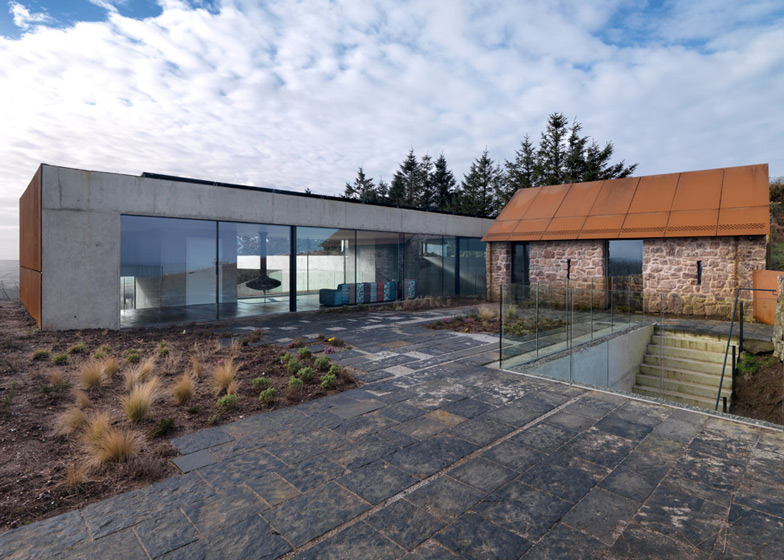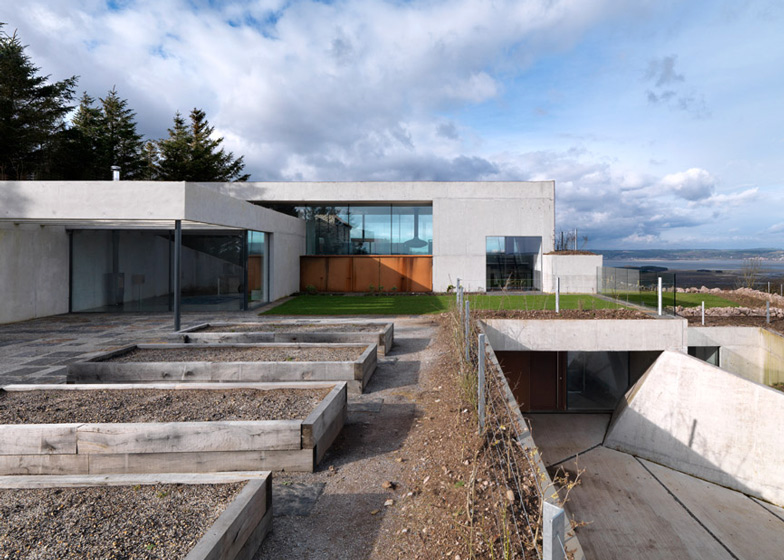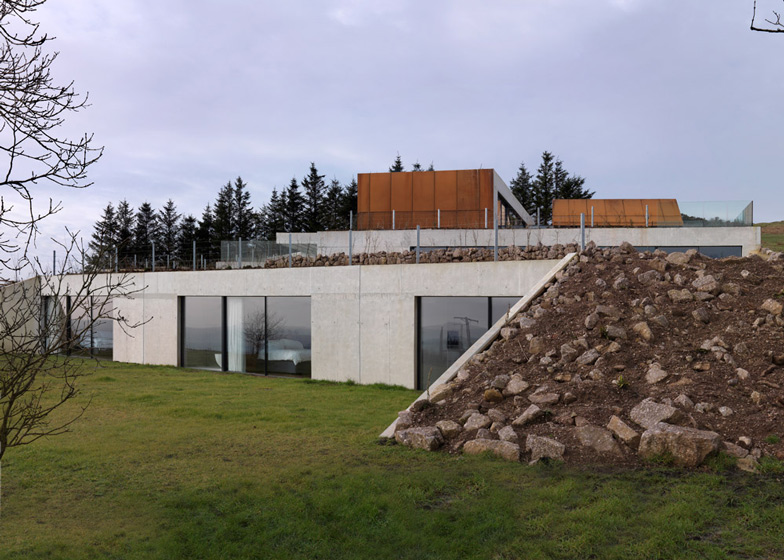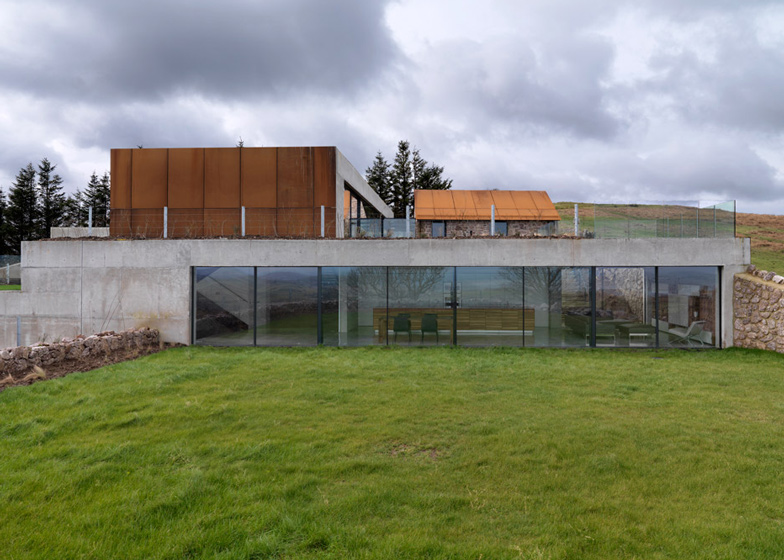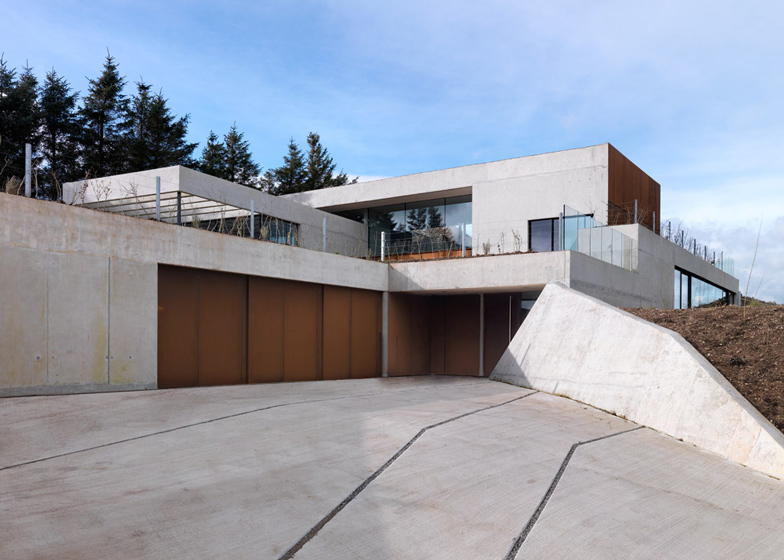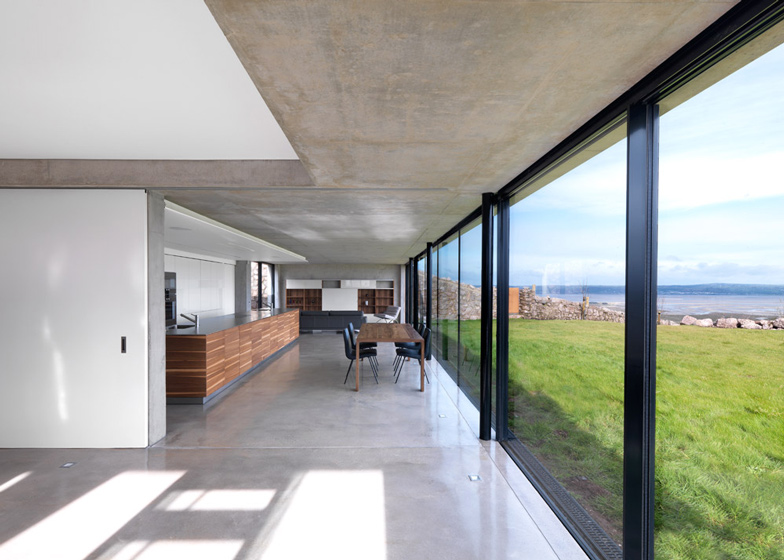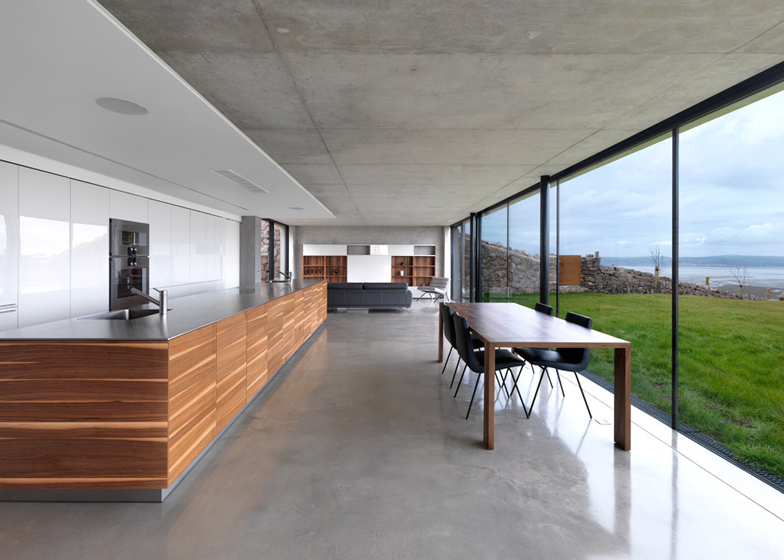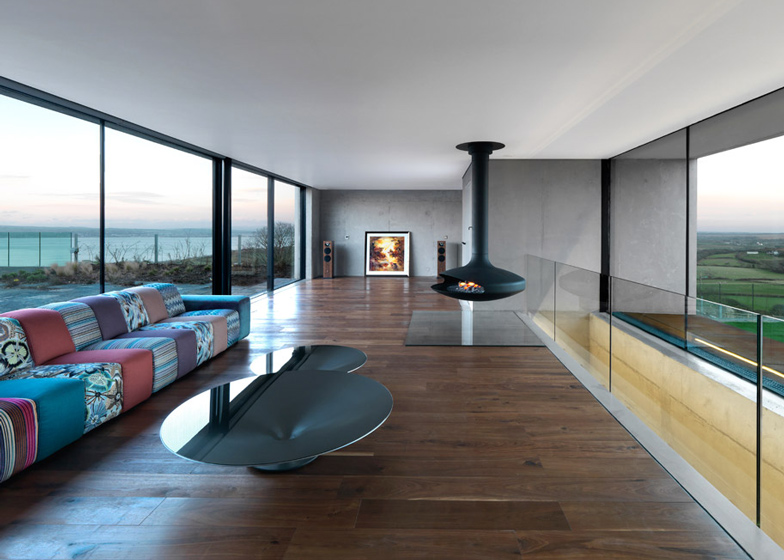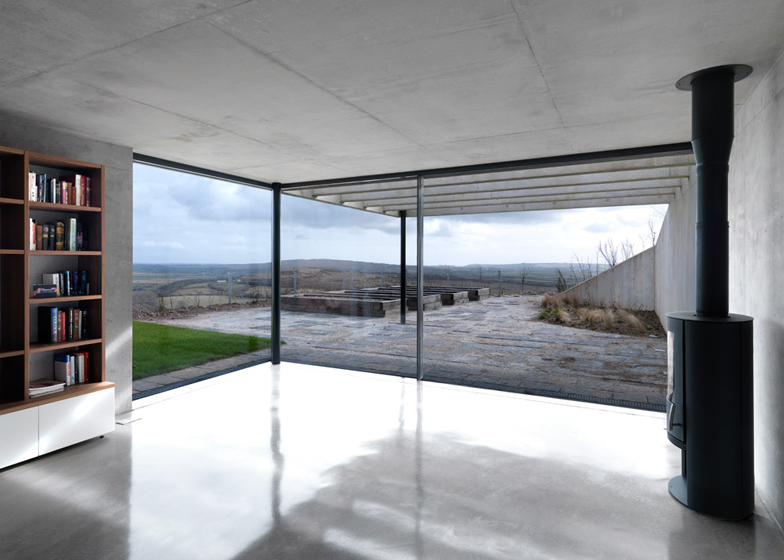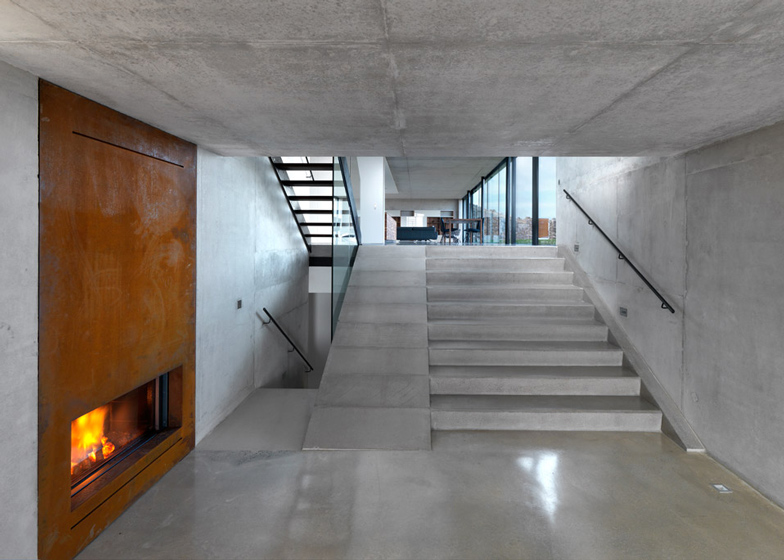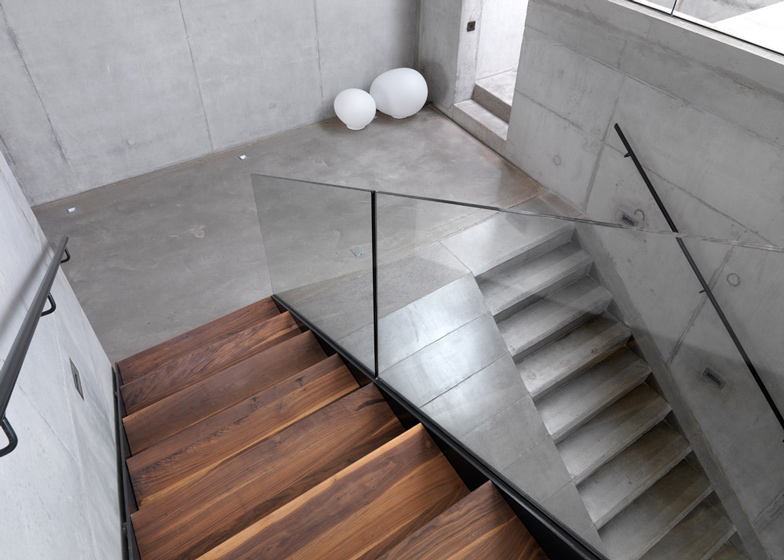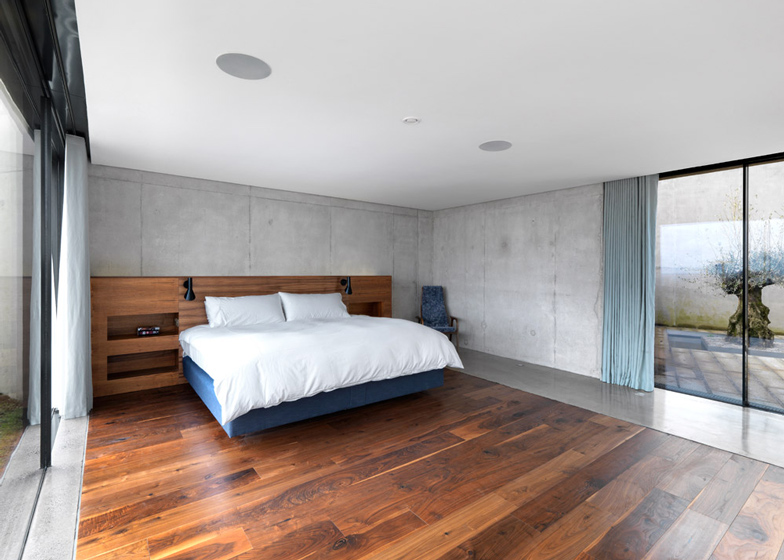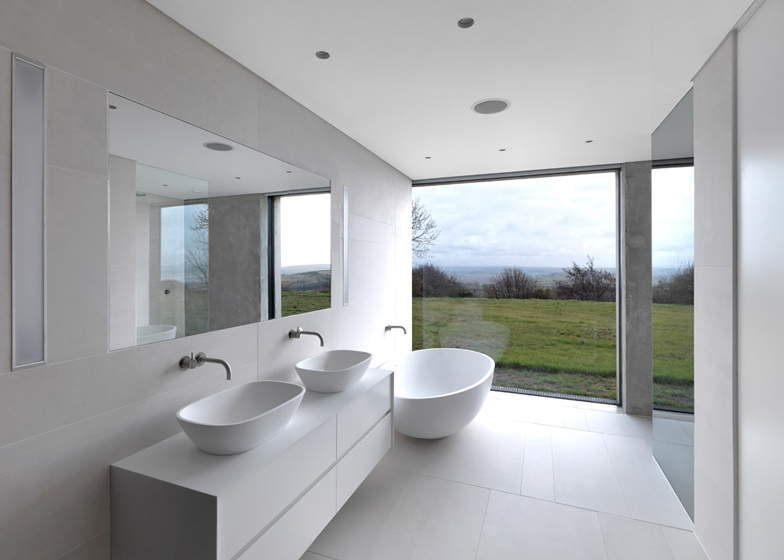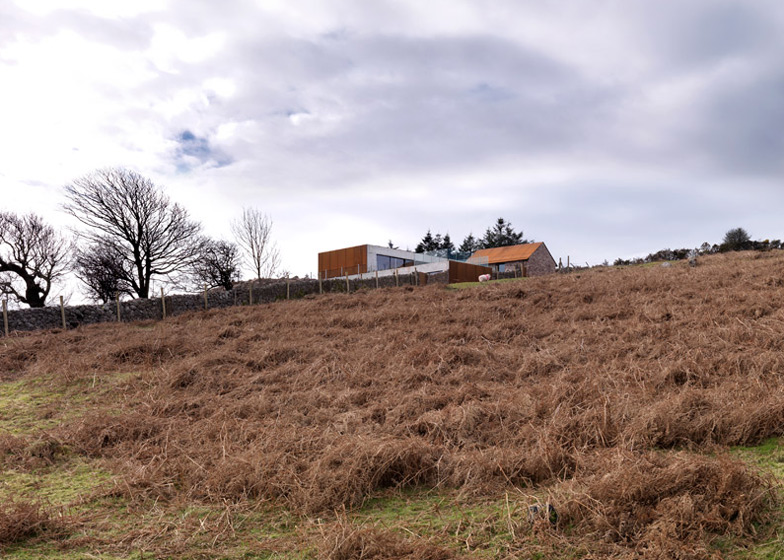Loyn & Co Architects has completed a home in a protected area of Welsh countryside, with old vernacular buildings sitting alongside modern additions featuring bare concrete and rusted steel (+ slideshow).
The Stormy Castle house is located within a designated Area of Outstanding Natural Beauty, meaning the design had to minimise any impact on the rural landscape. This prompted Welsh studio Loyn & Co Architects to arranged the volumes over three stepped levels, set into the slope of the hill.
"The proposal was embedded into the hillside, using the natural topography of the site to create an earth shelter dwelling," architect James Stroud told Dezeen. "In addition to the environmental and building performance benefits of this approach, it also provided a site-specific solution to our client's brief in terms of accommodation, and the nature and scale of the home they desired."
Materials were chosen to reflect the aesthetic of local farm buildings, which feature concrete and rusted metal. The tone of the weathered steel surfaces was chosen to match that of the bracken that covers some of the nearby fields.
Two historic buildings – a former school house and goat shed – were retained and renovated to accommodate new functions. The school house at the entrance to the site became a gatehouse and gym, while the goat shed is now used as a media room.
The clients also asked for the building to be sustainable, low maintenance and made to last a lifetime, so the architects employed reinforced concrete for the majority of the partly buried structure.
Spaces within the house are arranged around a series of courtyards and gardens that enable daylight to reach the rooms where it is most required.
"Our key challenge when burying large areas of the house was to ensure it would be filled with volume and varying light throughout the day," said Stroud. "Only in specific areas would you intentionally feel as though you were very much embedded within the hillside, to then be guided to another area of light and dramatic, ever-changing views."
A sloping driveway leads to the building's entrance level, where rusted steel doors open into the garage and a lobby area. This space features a fireplace and stairs leading to the dining room and adjacent kitchen, which are flanked by full-height windows looking out onto a flat garden.
A small family room at the far end of this floor features built-in bookshelves on the back wall and sliding doors that lead out to the garden on one side, and a smaller garden and courtyard on the other.
Stairs from the entrance hallway descend to the sunken sleeping level, which contains three bedrooms and a multi-purpose space, as well as an area for the home's technical facilities.
The master bedroom and multi-purpose space both feature sliding doors that connect them to a small courtyard, while the bathroom and each of the bedrooms is flanked on one side by a glazed wall providing views towards the horizon.
The highest level of the house accommodates a long living area with glazing on either side and a suspended fireplace providing a central focal point.
A flight of stairs descends from the living area to a landing connected to an office with its own fireplace. The media room sits alongside and is accessed via a glazed connection.
Large paved courtyards surround the rooms on the upper level, with the office opening onto a south-facing space featuring a concrete pergola and large wooden planters.
On the other side, the glazed living room and media room flank a courtyard that stretches out towards a viewing area built on top of the family room and incorporates a staircase leading to the kitchen courtyard below.
Photography is by Charles Hosea.
Here's some more project text from Loyn & Co Architects:
Stormy Castle, Gower, Wales
Stormy Castle is a purpose designed, Code 5, site specific family home, constructed in a remote location in Gower, Wales. The brief for the project evolved through detailed discussion with the client and a thorough understanding of the site. The existing main house was to be demolished and replaced with a contemporary dwelling that responds sensitively yet positively to the site, creating a timeless, high-quality architectural solution carefully integrated into the landscape.
A functional brief was provided by the client which identified desirable and undesirable characteristics in order to guide the design, without being prescriptive. Fundamental to the brief was the desire for a low energy, low maintenance, sustainable, lifetime home achieving a high level Code for Sustainable Homes.
The site lies in an exceedingly sensitive rural location on the North Gower coast, on the edge of National Trust land, occupying an elevated position. It lies within a designated Area of Outstanding Natural Beauty near to the remains of a Celtic hill fort. The site is remote and is accessed off a shared private track.
The scheme was inevitably going to be controversial and it was clear that achieving planning permission would not be straightforward. The project was commissioned in late 2008. Design proposals evolved following an extensive analysis of the site and budget, presentations to Swansea Planning Authority, local Community Groups and the ‘Design Commission for Wales’. DCfW were highly supportive of the design approach and “innovative design in a protected landscape”. In association with the Landscape Architects, Landscape Visual Impact Assessments were undertaken. Planning permission was granted in December 2010.
Principal materials selected for the project were insitu concrete, using GGBS, the only logical material for an earth shelter construction, with elements of Corten and glass. This combination gave the required low maintenance and longevity, whilst providing a raw, honest aesthetic appropriate to the site. Concrete is widely used in the local agricultural buildings, as is rusted metal, which also tones magnificently with the rich brown orange of the surrounding bracken and landscape generally. Having considered the optimum way of building into the hillside, the form has been designed to respond to the fall of the land, and recognising that the new house should respect the beautiful landscape setting; flat ‘green’ planted roofs, which along with improving the insulation also create useable terraces, were logical design decisions.
The dwelling was conceived as three stepped ‘wings’ set into the landscape, following the contours of the land, with much of the proposed dwelling cut and sunk into the sloping site, reducing massing, visibility and impact. This fragmented form evolved in response to the site topography, climatic considerations, orientation - planning the accommodation to take account of room function and sun path, combined with desired views, privacy and internal organization/room relationships, access and circulation. The extensive landscaping scheme provides manicured areas close to the house, including a sunken secret courtyard offering a protected suntrap, with the remainder of the landscape being returned to wild hillside, meadow or heathland.
The project has surpassed all targets set at the time of the client’s original brief and the pre-construction figures produced by the M&E consultant and Code Assessors. These include achieving Code for Sustainable homes level 5, an EPC certificate rating A, following a 100/100 score and an Actual Building Emissions Rate of -0.46 Kg/m2 against the Target Emission Rate 22.55 Kg/m2. The building uses a combination of a highly insulated fabric including Green roofs and technological systems to achieve its credentials. Systems such as Photovoltaic Solar Panels, Solar Thermal Panels, ground source heat pump, rainwater harvesting, wood burning stoves and MVHR have all been installed. In addition a low energy LED lighting scheme has been specified through-out and the building complies with the Lifetime Homes Criteria.
The finished product is a testament to the strong relationship between client, architect and contractor and is a remarkable achievement for replacement buildings and housing within a designated Area of Outstanding Natural Beauty and for architecture in Wales. This is a home designed to change, to reflect the client’s changing needs, to settle and mature within its surrounding landscape, and to suggest a new approach to sustainable, site specific, passive design in housing.

